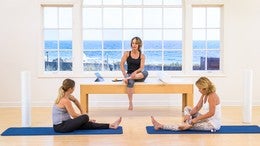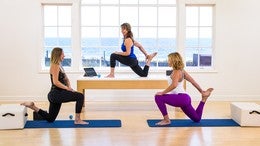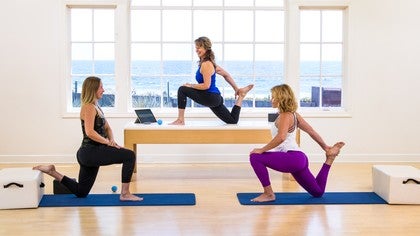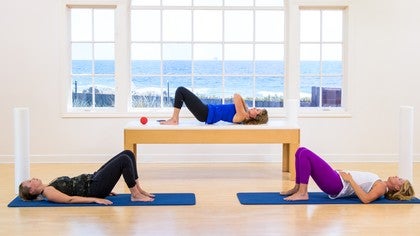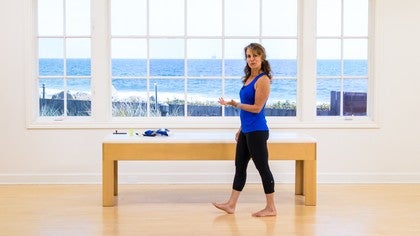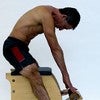Description
About This Video
Transcript
Read Full Transcript
Hi, I'm Miriam Kane. Welcome back. As we continue our dialogue on running free and simple, today we'll be addressing the spine and the role that it plays in our running practice. So let's just think about for just a moment what the spine does for us. It gives us structure. We have it hopefully available to us for the long run, pun intended, and just standing day to day, walking day to day.
It houses a very delicate spinal cord for us and protects it as well as creating structure for our body. We have seven cervical vertebra that form our neck, the thoracic spine that also creates a cage to protect those organs and our lumbar spine, which is our load bearing wall. Um, we also have a sake room and a coxix that little with varying amounts of vertebra there. Um, what we're going to be talking about today is how the, the spine reacts and what it does for us in the gates cycle. So as we've been discussing, the gate cycle begins when one foot touches the ground and ends when that same foot touches the ground again, whether we're walking or we're running. When we're walking, we are on one foot or both feet. When we're running, we're either on one foot or no feet. We're in flight. And so what happens with the spine is it gives us not only that structure and of holding us in a neutral spine or and good, um, biomedical mechanics, but also of countering what is happening above with what's happening below. And vice versa. As the pelvis rotates the upper part of the spine, the shoulder girl girdle will rotate to counter that.
Now when we talk about the various sections of the spine, they were designed to have a certain amount of stability or mobility. The lumbar spine being our load bearing wall. It's very important again for us to know where our neutral pelvis is. Otherwise it puts pressure either on the front or the back of those vertebra. The thoracic spine is designed to be mobile so that we have some rotation and unfortunately because of our lifestyles today, we're seeing that lacking in the majority of us.
So we'll be addressing that today. The thoracic spine as well as far as mobility, going side to side needs to also have mobility going in and out. That is very, very important. So we'll talk about that a little bit later. The cervical spine, we talk about a lot about the low back. We talk about the Middle Bolt, middle back, but in today's environment with all the Pokemon go that we're playing, and I'll bet when we're on the computers, just kidding, but and watching TV, we tend to be in this posture or even if we're really good about this, we tend to be a little bit here looking there and that creates a lot of issue intention.
The lower part of the cervical spine is designed to hold up this very heavy head. The upper two vertebra are designed to have a lot of mobility. I mean, we can do so much. It's amazing up here, but unfortunately they tend to switch positions when they don't get what they need. And we ended up being really tight up here and to mobile here. And same with our thoracic spine, creating maybe becoming too tense and then having issue below. So let's talk about setting up for our running experience so that those things actually don't happen.
So as I was just talking to you and we were just discussing the areas that tend to lack in the mobility or stability, I just want to make a little point and I think if we do this together you'll understand what I mean. Breathing is critical. We tend to hold our breath. Amanda and I were just talking about how fast we all move through life. I think we would all agree on that and we need to step back and we need to breathe. When someone is in a state of panic, a friend, the first thing we tell them is breathe. Take a breath. Right? But do we actually do that? So let's go ahead and put our hands on our ribcage like so.
And we are going to take a nice deep breath and exhale everything out.
So you can see where we also need the mobility in that rib cage so that we can take in that breath. Very important first and last thing we ever do. So the mobility of the spine is necessary in the rib cage. We're talking about that. I'll show you how to release that if that's not happening. And also I'm at the, so the spine counters, we were talking, I wouldn't say that accounters let's say it flows and it allows the countering from the shoulder of the pelvis. As the pelvis rotates, the shoulder goes in the other direction. So as we've been working on the gait cycle, standing or one leg goes forward, the opposite arm goes forward. That's what we're talking about.
And regards to the core. This is super important as well. We were discussing the, actually this is so important and this is so important that we talk about it all the time. And Pilati is our neutral pelvis, right? So neutral pelvis, neutral pelvis, we only neutral pelvis. Why do we need neutral pelvis? So it's the bridge between the upper and lower body. We discussed that in the pelvic um, segment that we, uh, for runners that we were talking about just recently. Um, also the pelvis is stabilized by way of the transverse abdominis. So we think of the abdominals as the rectus Abdominis, the eight pack, right?
And the obliques, which are like a core set and they help us to rotate and laterally flex. Well, those guys are fast twitch muscles and they are primarily fast twitch fibers. I should say. We have both, but they're primarily that the transfer versus of dump. Transverse abdominis is primarily, um, a slow twitch fiber, meaning that it's designed for endurance and it has a best friend. The [inaudible], when we looked at the pictures of the spinal muscles, um, we saw those muscles running all the way up that spine and we saw them [inaudible] they react to the transverse abdominis drawing in by extending all the way up the spine, like scaffolding. And I'd find that to be just absolutely amazing.
They work in tandem as a team to stabilize that spine and they have more proprioceptors in the multiplet than they do in any other part of our body. Each one of those little guys knows exactly where that vertebra is supposed to be. So let's just say that the transverse abdominis is really important for our spinal health. OK. And that said, we're going to go into our self maintenance tools because this is what we're talking about. We shouldn't be afraid of signals that the body gives us. We can understand pleasure, but we get really freaked out about pain. So if I touch something that's super hot, I understand that that pain was to tell me to take my hand away. But if I feel something that's nagging and nagging kind of ache, I think immediately that something's really wrong and that that could be the case and we may need to get it checked out, but often not is not the case.
It's just a signal that the body needs change. We've been talking about homework, um, the clients of mine that do their homework and you know who you are, it's very obvious. They take 10 minutes a day and some of them more. And many of them, I'd say 90% of my students come into the studio 10 to 15 minutes early to do release work and it really shows in the changes of their body. And I know that's what you want as well. So I can't encourage you enough to just give yourself those 10 minutes to do the homework that you need for your body, whatever it's asking for.
We're going to start today for the spine with soft tissue mobilization and we're going to use to start a foam roller. So if you have a foam roller right now, I'd encourage you to go ahead and take it. I'm going to grab mine and you're gonna take your foam roller and you're going to place it mid back like stuff. Okay? And then you're going to use your arms to kind of cantilever a little bet just to take maybe a little bit of pressure off of your back at first until you see what your body's willing to accept. And it can change day to day. And then you're going to lift your bottom a little bet. And I like to just lift the bottom and kind of move just a little bit just to get an idea of what is presenting today and to give the body a heads up. And then we're gonna drop the bottom just a wee bit.
Bring her hands behind our head to support. And when you have your roller placed, it should be right about the mid thoracic spine. And just going to go back a little bit. So the first time you go back, I don't like going back very far. I come right back up and I say, okay body, is that okay? And it might say yes and I may say no. So if it says no, I'm gonna honor it and I'm gonna move down just a wee bit more. It's not in the lumbar spine that we're trying to mobilize. It's in the upper thoracic or excuse me, in the thoracic.
And so then we're going to move back another little segment and come back up. So I'm kind of assessing right here. I moved back to assessment because I think this is important just to see if I feel a little bit stuck. So I like to start with this and now that I've done that, I'm going to lift my bottom and I'm going to bring my hands across my chest and I'm going to walk back and I'm going to walk forward. And as I feel more comfortable with it, I'm gonna lift my bottom a little bit more and put a little bit more weight and go all the way to my shoulder blades back and forth and back and forth. Nice. And that's a good start. We're going to bring ourselves right back up.
So we're getting a sense of where we might have tension. We don't need our rollers anymore right now because now we're going to take it away from more of a global mobilization to more of a local mobilization. Okay. So we're gonna take these two balls. Some people like to put them in a sock or in something, or some people tape them together. Um, I don't find that they really go away too easily, so we're just gonna use them separately. But what I'm going to do is I'm going to place them up here on my thoracic spine to start, and they're not on the spine proper. They're on both sides. So we're going to go ahead and lay down and we're going to place them right at the top. I'll move down so I don't roll up here, right there.
And then you're going to lift your bottom. So you might want to loosen up your shirt so you don't get choked and you're gonna lift your bottom and you're gonna move up. Oh, it could be a half inch, it might be a quarter inch. I bet you already know if you're there and you might find a spot already. We're going into the upper trapezius here and you're just gonna stay here for a moment. You might lift your bottom and go back and forth. How are we doing ladies? Okay, we're going up and down and then you're going to take your arms and you're gonna Cross them over. So one hand is on the opposite shoulder.
So what you're doing is you're separating out your scapula and you continue going on. I'm going to come up so that I can talk to you and see what you're doing. Wonderful. And so you're going to continue moving up a little segment at a time. You can bring your arms out to the side and you can do a little snow angels if you want to, or carpet angels and see what your shoulders have to say. So we were talking earlier and you ladies just continue moving down.
So you moving down both sides and you're noticing what the body might have to say and take your time. So it shouldn't be excruciating, excruciatingly painful, but it could definitely be very tender. And we're just going to lay, when you find a spot and then you're going to drop your bottom to bring on a little bit more weight. There you go, man. Go ahead and drop that bottom and you're gonna stay there for just a moment and you're going to breathe. Nice. That's what the idea is to give yourself what you need. And we give our bodies what they need.
They're going to give us what we're asking. We tend to ask a lot, a lot of debit and not enough credit and therefore we wonder why they get a little grumpy. But I think this'll help. And then we're going to move up just a tad bit more. And so we're moving our way down and are we finding some spots of interest? Yeah. Nice. And so we're coming off the mat here, so don't be afraid to Scooch scooching back down and that's what's going to happen. You start to travel across the floor and this is something that if you have dogs, you might want to have them in another room. When you're doing that, they get really fired up when they see these balls. Okay, so I know that we could do this all day long, but what we're going to do now, when you're doing this at home, please take your time, take time to take care of yourself and don't rush through this.
We have been working on the mobility of the thoracic spine so that we have our rotation and our lateral flection if necessary, while we won't need lateral flection for running, but we do need some rotation. And then let's talk about the shoulders a little bit. We were talking earlier how the shoulder movement or the arm move at counters. What's happening at the pelvis is almost, it goes, if you think of yourself crawling to coming up and walking and then now we're going a little bit faster, shorter Leber's at the, but we need that elbow to be able to go back and again, because of our lifestyles, um, quite often we'll see anteriorly rotated shoulders and that if we're running with our shoulders anteriorly rotated, look at what happens at my arm. So now I'm crossing this way. So when you're, if you see or notice that you are running with your elbows, that's the side.
Your upper traps might be a little snug and we worked on a little bit of something for that. But also you might be rotated forward from the PEC minor. There's a series of possible culprits right in here. So we're gonna address that. Now, Mandy, do you mind coming up here? So if you have a ball, you could, I have had this guy, he's, he's a pretty spiny guy and we've got the Lacrosse ball. One thing you can do, and you can do that, we can do this together as you can take this ball. If this is new to you, it's a good way to start.
We're looking at gradual progression and just press into the Pec minor and going across and do you feel anything in there? Okay, wonderful. Well then we're going to take it another step further and here's what we're going to do. If you can lay face down for me and we're going to use this ball and I think Manny and I will still be friends when this is over, but we're going to take this Bob and I'm going to place it. Same place. We were just rolling, so if you're going to let you place it and then move your hair so we can see what we're doing here. And Mandy's face was actually going to turn away from our spot of interest.
Okay. How are you doing there? Can you feel anything? Move it just a little. There you go. So she's moving the ball probably, I'm guessing more into the PEC minor. Maybe a little bit more. A little closer in towards her sternum. Are we there? Okay, so she is, yes, there she says, right. Do you feel that feel good? It feels interesting. It says, she says, it feels interesting. Okay, so you see where this ball is place. So you're doing the same thing I'm sure at home.
And do you feel a spot of interest? And now what you're going to do is with your arm bone, you're going to, anteriorly you're going to rotate in, you're going to rotate out. It's kind of like you're palming the basketball. Okay. That's really in, does that do anything for you, you guys on the external, on her external rotation, she's feeling some stretching going on in here. So it's not so much stretching as it is actually tissue mobilization. She's flossing per se. It's pinned and as she's moving, those muscles are having to move around that pinned area. Wonderful.
Thank you ma'am. So then we're going to take this ball out and you can stay here if you want for just a second because there's a great stretch that we can do for this. Um, this is another of Anthony, less stretches, but if you bring your hand to the 90 degree angles are like a goalpost. And then what [inaudible] is going to do is she's going to use the other hand as her kicks down and she's going to push herself over. This leg is going to come over as well until she feels a stretch or you feeling that stretch yet Mandy. So she feels a stretch. How's that feel? Good. Good. And once you feel that stretch, the elbow should definitely be in alignment with the shoulder joint.
Once you feel that stretch, then you're going to contract. So you can think of pressing, I think, press the armpit down and you're going to do that for three breaths. Nice. Inhale and exhale. Inhale. And one more breath.
And then allowing yourself to relax and see if you can push yourself. I've got you over just into a little bit deeper stretch. How are you there? Oh, it's intense. It's intense. It's probably intense for all of us just because this is a lifestyle issue that we have. So start gradually. What Mandy could do then is possibly walk her fingers up and she'll find that she's maybe going to feel this radiate a little bit further into the Pec minor. Yes, yes, you okay.
So gradual progression. Remember this as something that is a thread that runs through everything we do. It doesn't happen overnight. Start Small and then feed it in progressively, maybe a little bit deeper at a time. Excellent. And I think Mandy's had just the right amount of this stretch so you never come out of this quickly.
We're very slowly going to return you to bring your leg back down and this elbow will slowly come back down. Allow your body, your body to just generally gradually progress in and out of any of these movements. And I trust that at home you are now going to do that other side. Thank you very much Mandy. Come on back into a rest position. Nice work. We're going to take the swell and we're going to place it right on the outside of the spine, right above the hip. So feel around for your pelvis. It might be higher up than you think. And then you're going to bring the ball right there.
And so we're just going to do one at a time and then we're going to go from the spine out and from the spine out. So a little bit of a rocking movement. So we're going across the spa, the fibers of the low back extensors and across, I hope you can see what I'm doing and across and I'm going to do the other side as well so you can see that. Okay, so again, bringing it right to the side of the spine and then just twisting. So there's many ways of mobilizing soft tissue. I know my chiropractor really opened my eyes to this with the Graston technique years ago, and then I've since learned some self-help tools and sometimes you go across the fibers, sometimes you sink in, I'll come back up, now you continue. But regardless, there are many methods to get to what we're trying to do, which is to create, glide and you have to find what works for you. I find this to be something that's very helpful.
I know we use these on the plane coming out here to California and those balls kind of travel with me everywhere. It's just a really quick, easy fix for when we need a little bit of help. All right, wonderful. Excellent. And I know you ladies feel free to continue on, but we're going to move on to, um, some stretches. So again, uh, what about stretching and do we actually need stretching? That's a very personal thing. I think. Um, you have to understand where your body is lacking mobility. You're releasing soft tissue, so now you're giving your body the tools to have the glide. Sometimes just having the glide is sufficient and then you find that you naturally have the range of motion. Sometimes we need a little bit of extra. Okay. So what we're going to do right now is just a little stretch for the back, um, for all of the extensors that run from the tailbone all the way up the spine.
And you're just going to bring your knees, come to a seated position and just rest on your legs and enjoy doing that. And if you need to for comfort, you can bring your legs apart a bit. And then now you're going to go ahead and grab your feet and you're going to walk them away a little bit.
You're gonna Relax your neck and think of a nice evenly extended arch from the crown of the head. I know I'm probably up here. I'm going to change that and try to go into my lumbar spine because that's my area right here that has really difficult time relaxing the feet. And now what we're going to do is we're going to draw the abdominals in and imagine pressing that spine away from us
This is a reason draw the abs in that we need the transverse abdominis here to stabilize is because otherwise we would just be hanging in our backs. But right here the back is feeling the stretch from the contraction in the front. So if the back is too tight to allow the contraction, that makes sense, right? Then we have a problem. And so we're going to come right back up and extend the spine and lengthen it. And then we're going to do that again. We're going to extend the legs this time and we're going to see where we can fold ourselves over.
So we gave her body a little bit of a heads up with that stretch. So now that we're here, I want you to think again of creating a nice long art from the crown of your head. You're reaching away through your tailbone. Take a nice deep breath. Exhale, press into your back and then release and come forward. And of course you can do that for a longer duration. Your knees can be bent, it's wherever you are today. You can be seated, you can be holding on to something and reaching away from it. Many variations, whatever works for you. And you're going to come all the way back up and lift your heart and hopefully feeling a little bit mobile, more mobile, and your extensors. Okay, great.
And now we'll address a wonderful stretch for the side of the body. Again, those obliques and muscles that can cause us to become tight in rotation. So we're going to grab some boxes for the sake of this stretch. And if you can grab a chair, that would be a great place for you to sit. Wonderful. And I'm going to sit right here. Okay. So we'll be sitting on our boxes like [inaudible], legs crossed and relaxed in front. If you're sitting on a short stoll, that would work really great.
And you can hold onto the size if you'd like. Oh, for the neck. I think we'll hold on right here instead. Okay. So I'd like you to go ahead and reach down. You can put your hand underneath of your chair. If you're sitting in a chair, take a nice deep breath and exhale out. And you can bring the arm. What are whatever arm you want to bring up, up and over, and you're holding on so that you don't fall off and you're going to go up and over. So notice I didn't say you just go over.
You're going up and over creating space. Oh, that feels great. And relaxing the shoulders. So notice if you're feeling any stress anywhere and I want you to ask it to please relax. Take a deep breath in and exhale. And now reach out through this fingers. And then we're going to press this side of the body that we're stretching away from us as if we're just trying to reach retreat away, pressing into something for two breaths.
And again, noticing what we might feel. It could be under the armpit where your lats attach and bringing it back and slowly reaching up high and bringing it back. How did that feel? Nice. All right, I hope you enjoyed that. That just feels great. Okay. Take a deep breath. Only one other side. We're going to grab again to just have some stability. Bring this arm up, up and over.
And I remember we're going up to decompress the spine and over and reach nice and long. So notice that this side of the body is telling you something else. I know mine is. So we're gonna pay attention and why? If it's gripping, why is it gripping? And do we just tear it away from being a gripping muscle? Or do we just try to understand why it would be holding on and instead giving it permission to let go? So let's draw the abdominals then oftentimes that's why the muscles get tight. That's because they're not getting the support that they need.
And now we're going to press in. So this side of the body is trying to press into the air over here for two breaths and one and now we're gonna add that little rotation. It's not a big rotation, but just a little rotation. And notice what you might feel here. And as you do this, you might notice that, Ooh, if I just contract a little deeper, I can get a little bit more into these muscles. They feel like they need a little bit more love as well. And then we'll come back and then we'll go in the other direction.
Just looking up to the sky, noticing what we feel here and coming all the way back up. Nice and long. Beautiful.
Where do you feel that you lack mobility? Where do you feel that you might lack stability and where do you feel that you might need strength? And for some of us thinking we lack gives us a feeling of I'm not doing well enough and it's not that at all. Our bodies go through life being asymmetrical. I don't use my mouse with my left hand, but maybe I should. And we do things asymmetrically.
So there's really no reason that our bodies would be able to work symmetrically unless we actually start to bring that practice in. And that's what I'm encouraging to do so that we can run free and without pain. So thanks for joining me and I hope to see you in the next tutorial where we'll be talking about Palladio's magic and I hope to see you on the mat as we address everything that we've found so far.
Pilates for Athletes: Running Free
Comments
You need to be a subscriber to post a comment.
Please Log In or Create an Account to start your free trial.

